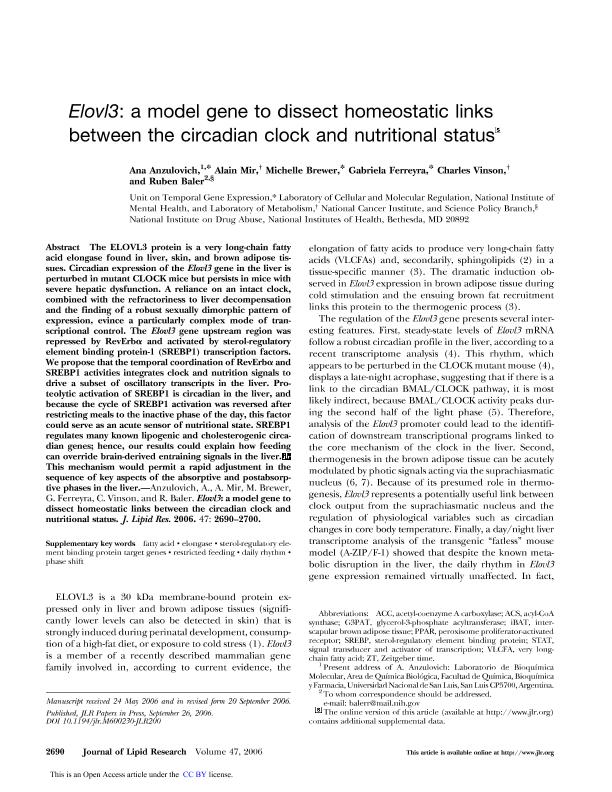Mostrar el registro sencillo del ítem
dc.contributor.author
Anzulovich Miranda, Ana Cecilia

dc.contributor.author
Mir, Alain
dc.contributor.author
Brewer, Michelle
dc.contributor.author
Ferreyra, Gabriela
dc.contributor.author
Vinson, Charles
dc.contributor.author
Baler, Ruben
dc.date.available
2022-06-03T15:36:10Z
dc.date.issued
2006-12
dc.identifier.citation
Anzulovich Miranda, Ana Cecilia; Mir, Alain; Brewer, Michelle; Ferreyra, Gabriela; Vinson, Charles; et al.; Elovl3: a model gene to dissect homeostatic links between the circadian clock and nutrition status; American Society for Biochemistry and Molecular Biology; Journal of Lipid Research Papers In Press; 47; 12; 12-2006; 2690-2700
dc.identifier.issn
0022-2275
dc.identifier.uri
http://hdl.handle.net/11336/158895
dc.description.abstract
The ELOVL3 protein is a very long-chain fatty acid elongase found in liver, skin, and brown adipose tissues. Circadian expression of the Elovl3 gene in the liver is perturbed in mutant CLOCK mice but persists in mice with severe hepatic dysfunction. A reliance on an intact clock, combined with the refractoriness to liver decompensation and the finding of a robust sexually dimorphic pattern of expression, evince a particularly complex mode of transcriptional control. The Elovl3 gene upstream region was repressed by RevErbα and activated by sterol-regulatory element binding protein-1 (SREBP1) transcription factors. We propose that the temporal coordination of RevErbα and SREBP1 activities integrates clock and nutrition signals to drive a subset of oscillatory transcripts in the liver. Proteolytic activation of SREBP1 is circadian in the liver, and because the cycle of SREBP1 activation was reversed after restricting meals to the inactive phase of the day, this factor could serve as an acute sensor of nutritional state. SREBP1 regulates many known lipogenic and cholesterogenic circadian genes; hence, our results could explain how feeding can override brain-derived entraining signals in the liver. This mechanism would permit a rapid adjustment in the sequence of key aspects of the absorptive and postabsorptive phases in the liver.
dc.format
application/pdf
dc.language.iso
eng
dc.publisher
American Society for Biochemistry and Molecular Biology

dc.rights
info:eu-repo/semantics/openAccess
dc.rights.uri
https://creativecommons.org/licenses/by/2.5/ar/
dc.subject
ELOVL3
dc.subject
CIRCADIAN RHYTHM
dc.subject
LIPID METABOLISM
dc.subject
LIVER
dc.subject
FATTY ACID
dc.subject
ELONGASE
dc.subject
STEROL-REGULATORY ELEMENT BINDING PROTEIN TARGET GENES
dc.subject
RESTRICTED FEEDING
dc.subject
DAILY RHYTHM
dc.subject
PHASE SHIFT
dc.subject.classification
Biología Celular, Microbiología

dc.subject.classification
Ciencias Biológicas

dc.subject.classification
CIENCIAS NATURALES Y EXACTAS

dc.title
Elovl3: a model gene to dissect homeostatic links between the circadian clock and nutrition status
dc.type
info:eu-repo/semantics/article
dc.type
info:ar-repo/semantics/artículo
dc.type
info:eu-repo/semantics/publishedVersion
dc.date.updated
2022-05-20T15:05:22Z
dc.identifier.eissn
1539-7262
dc.journal.volume
47
dc.journal.number
12
dc.journal.pagination
2690-2700
dc.journal.pais
Estados Unidos

dc.journal.ciudad
Maryland
dc.description.fil
Fil: Anzulovich Miranda, Ana Cecilia. Consejo Nacional de Investigaciones Científicas y Técnicas. Centro Científico Tecnológico Conicet - San Luis; Argentina. Universidad Nacional de San Luis. Facultad de Química, Bioquímica y Farmacia; Argentina. National Institutes of Health; Estados Unidos
dc.description.fil
Fil: Mir, Alain. National Institutes of Health; Estados Unidos
dc.description.fil
Fil: Brewer, Michelle. National Institutes of Health; Estados Unidos
dc.description.fil
Fil: Ferreyra, Gabriela. National Institutes of Health; Estados Unidos
dc.description.fil
Fil: Vinson, Charles. National Institutes of Health; Estados Unidos
dc.description.fil
Fil: Baler, Ruben. National Institutes of Health; Estados Unidos
dc.journal.title
Journal of Lipid Research Papers In Press

dc.relation.alternativeid
info:eu-repo/semantics/altIdentifier/doi/https://doi.org/10.1194/jlr.M600230-JLR200
dc.relation.alternativeid
info:eu-repo/semantics/altIdentifier/url/https://www.jlr.org/article/S0022-2275(20)43261-4/fulltext
dc.relation.alternativeid
info:eu-repo/semantics/altIdentifier/url/https://www.sciencedirect.com/science/article/pii/S0022227520432614
Archivos asociados
